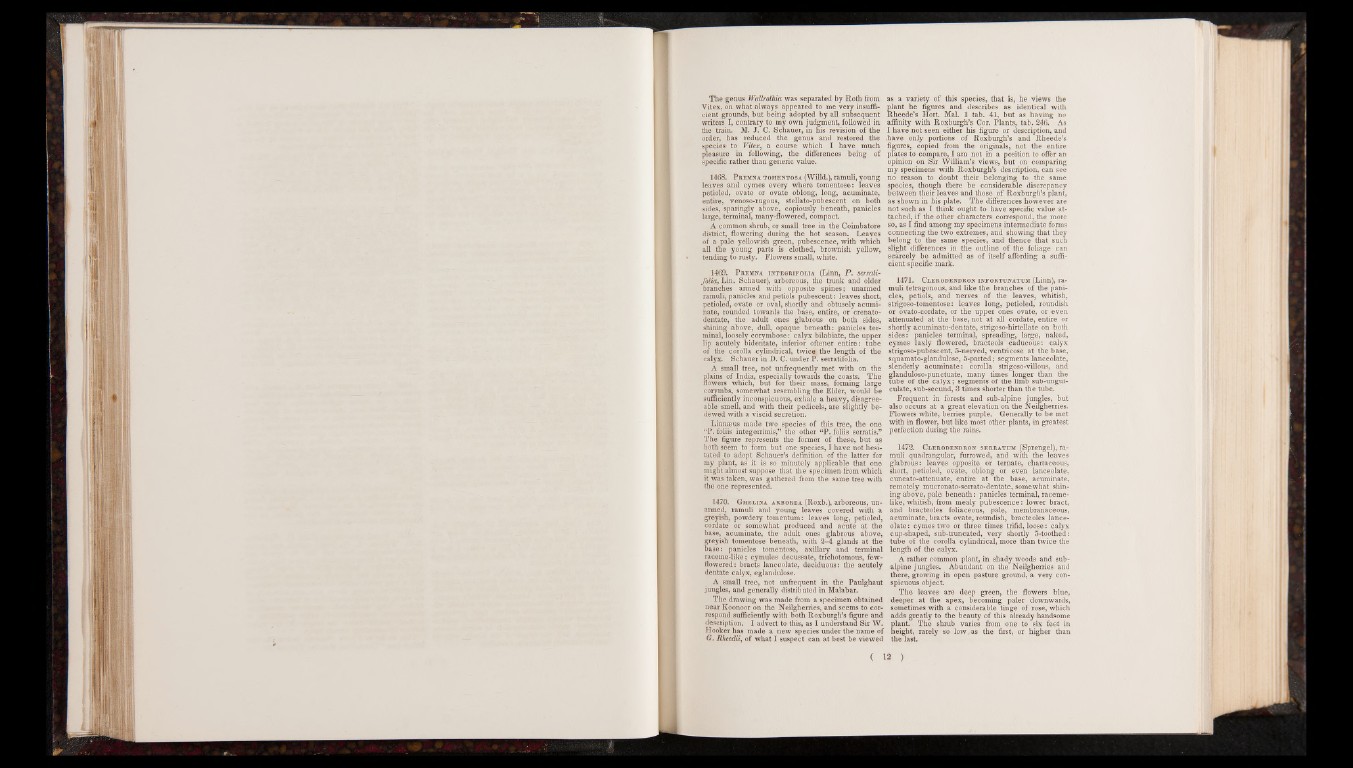
The genus Wallrothia was separated by Roth from
Vitex, on what always appeared to me very insufficient
grounds, but being adopted by all subsequent
writers I, contrary to my own judgment, followed in
the train. M. J. C. Schauer, in his revision of the
order, has reduced the genus and restored the
species' to Vitex, a course which I have much
pleasure in following, the differences being of
specific rather than generic value.
1468. Premna tomentosa (Willd.), ramuli, young
leaves and cymes every where tomentose: leaves
petioled, ovate or ovate oblong, long, acuminate,
entire, venoso-rugous, stellato-pubescent on both
sides, sparingly above, copiously beneath, panicles
large, terminal, many-flowered, compact.
A common shrub, or small tree in the Coimbatore
district, flowering during the hot season. Leaves
of a pale yellowish green, pubescence, with which
all the young, parts is clothed, brownish yellow,
tending to rusty. Flowers small, white.
1469. P remna integrifolia (Linn, P . serrati-
folia, Lin. Schauer), arboreous, the trunk and older
branches armed with opposite spines; unarmed
ramuli, panicles and petiols pubescent: leaves short,
petioled, ovate or oval, shortly and obtusely acuminate,
rounded towards the base, entire, or crenato-
dentate, the adult ones glabrous on both sides,
shining above, dull, opaque beneath: panicles terminal,
loosely corymbose: calyx bilabiate, the upper
lip acutely bidentate, inferior oftener entire: tube
of the corolla cylindrical, twice the length of the
calyx. Schauer in D. C. under P. serratifolia.
A small tree, not unfrequently met with on the
plains of India, especially towards the coasts. The
flowers which, but for their mass, forming large
corymbs, somewhat resembling the Elder, would be
sufficiently inconspicuous, exhale a heavy, disagreeable
smell, and with their pedicels, are slightly bedewed
with a viscid secretion.
Linnaeus made two species of this tree, the one
“P. foliis integerrimis,” the other “P. foliis serratis.”
The figure represents the former of these, but as
both seem to form but one species, I have not hesitated
to adopt Schauer’s definition of the latter for
my plant, as it is so minutely applicable that one
might almost suppose that the specimen from which
it was taken, was gathered from the same tree with
the one represented.
1470. Gmelina arborea (Roxb.), arboreous, unarmed,
ramuli and young leaves covered with a
greyish, powdery tomentum: leaves long, petioled,
cordate or somewhat produced and acute at the
base, acuminate, the adult ones glabrous above,
greyish tomentose beneath, with 2 -4 glands at the
base: panicles tomentose, axillary and terminal
raceme-like; cymules decussate, trichotomous, few-
flowered: bracts lanceolate, deciduous: the acutely
dentate calyx, eglandulose.
A small tree, not unfrequent in the Paulghaut
jungles, and generally distributed in Malabar.
The drawing was made from a specimen obtained
near Koonoor on the Neilgherries, and seems to correspond
sufficiently with both Roxburgh’s figure and
as a variety of this species, that is, he views the
plant he figures and describes as identical with
Rheede’s Hort. MaL 1 tab. 41, but as having no
affinity with Roxburgh’s Cor. Plants, tab. 246. As
I have not seen either his figure or description, and
Jiave only portions of Roxburgh’s and Rheede’s
figures, copied from the originals, not the entire
plates to compare, I am not in a position to offer an
opinion on Sir William’s views, but on comparing
my specimens with Roxburgh’s description, can see
no reason to doubt their belonging to the same
species, though there be considerable discrepancy
between their leaves and those of Roxburgh’s plant,
as shown in his plate. The differences however are
not such as I think ought to have specific value attached,
description. I advert to this, as I understand Sir W.
Hooker has made a new species under the name of
G. Rheedii, of what I suspect can at best be viewed
if the other characters correspond, the more
so, as I find among my specimens intermediate forms
connecting the two extremes, and showing that they
belong to the same species, and thence that such
slight differences in the outline of the foliage can
scarcely be admitted as of itself affording a sufficient
specific mark.
1471. Clerodendron infortunatum (Linn), ramuli
tetragonous, and like the branches of the panicles,
petiols, and nerves o f the leaves, whitish,
strigoso-tomentose: leaves long, petioled, roundish
or ovato-cordate, or the upper ones ovate, or even
attenuated at the base, not at all cordate, entire or
shortly acuminato-dentate, strigoso-hirtellate on both
sides: panicles terminal, spreading, large, naked,
cymes laxly flowered, bracteols caducous: calyx
strigoso-pubescent, 5-nerved, ventricose at the base,
squamato-glandulose, 5-parted; segments lanceolate,
slenderly acuminate: corolla strigoso-villous, and.
glanduloso-punctuate, many times longer than the
tube of the calyx; segments of the limb sub-ungui-
culate, sub-secund, 3 times shorter than the tube.
Frequent in forests and sub-alpine jungles, but
also occurs at a great elevation on the Neilgherries.
Flowers white, berries purple. Generally to be met
with in flower, but like most other plants, in greatest
perfection during the rains.
1472. Clerodendron serratum (Sprengel), ramuli
quadrangular, furrowed, and with the leaves
glabrous: leaves opposite or ternate, chartaceous,
short, petioled, ovate, oblong or even lanceolate,
cuneato-attenuate, entire at the base, acuminate,
remotely mucronato-serrato-dentate, somewhat shining
above, pale beneath: panicles terminal, racemelike,
whitish, from mealy pubescence: lower bract,
and bracteoles foliaceous, pale, membranaceous,
acuminate, bracts ovate, roundish, bracteoles lanceolate
: cymes two or three times trifid, loose: calyx
cup-shaped, sub-truncated, very shortly 5-toothed:
tube of the corolla cylindrical, more than twice the
length of the calyx.
A rather common plant, in shady woods and sub-
alpine jungles. Abundant on the Neilgherries and
there, growing in open pasture ground, a very conspicuous
object
The leaves are deep green, the flowers blue,
deeper at the apex, becoming paler downwards,
sometimes with a considerable tinge of rose, which
adds greatly to the beauty of this already handsome
plant. The shrub varies from one to six feet in
height, rarely so low , as the first, or higher than
the last.